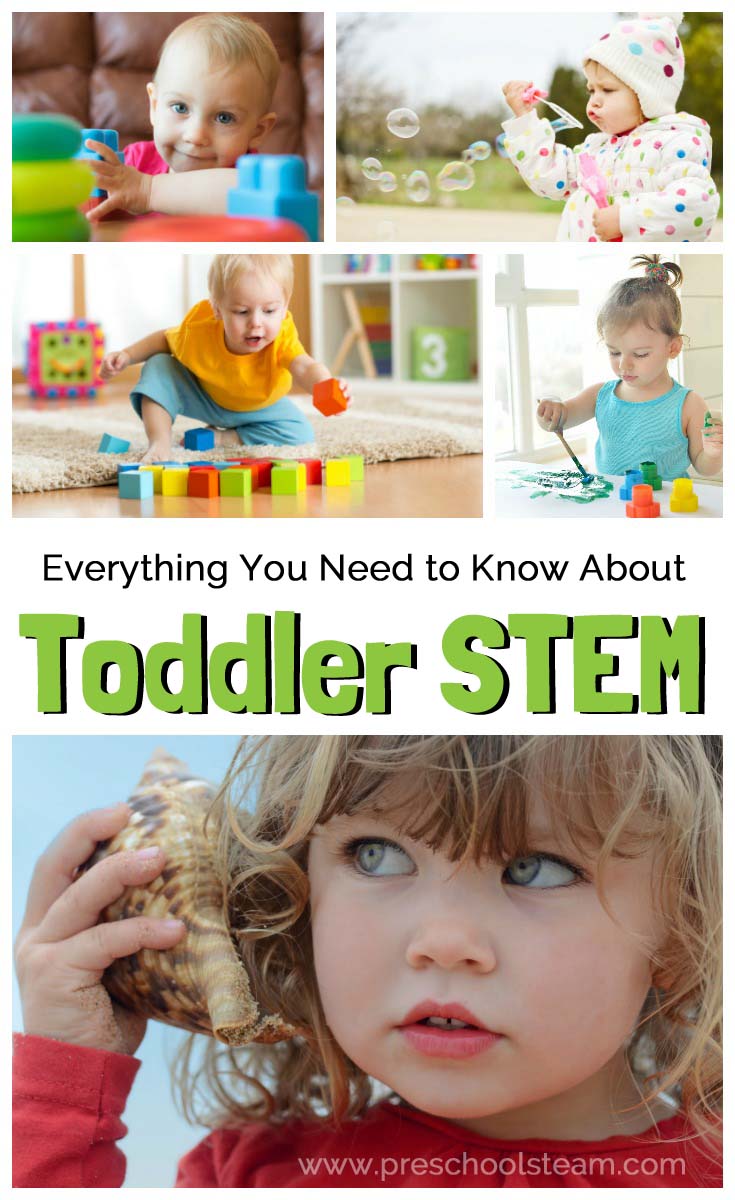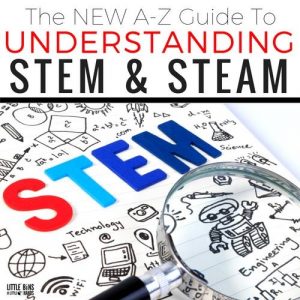Children naturally are inclined to STEM activities as they are naturally curious….especially toddlers! Have you seen a toddler conduct their own science experiment?

For clarification, we are referring to ages 1-3 when saying “toddler”.
My advice is quite simple in how to incorporate STEM activities for toddlers (or STEAM as we like to say)…
Let them play. Let them be curious.
Your job as the educator or parent is to provide materials, experiences, and opportunities for children to explore, discover and be curious.

There are two goals when planning STEAM activities for Toddlers:
- Create a safe environment for children to explore using their senses.
- Create natural learning experiences that led to discovery and inquiry.
What you can do to facilitate STEM learning:
- Provide a safe environment to explore
- Join in the exploration with the children. Build your relationship by exploring with your child.
- Connect current experiences to your child’s previous experiences.
Science Activities for Toddlers
At the toddler age, you want to start cultivating a love for science by encouraging children to be curious and ask questions. Sensory activities are important to include because toddlers use their senses to try and understand the world around them (like our example of a toddler eating a crumb off the floor).
Invite children to use their 5 senses to describe what they see and observe.
- How does it feel?
- What does it look like?
- What does it smell like?
- What do you hear?
- How does it taste?

Science Activities for Toddlers:
- Go outside! Let your child explore and describe what the see, feel, hear.
- Paint on the pavement with a bucket of water and a brush
- Drop different size objects into a bucket of water.
- Build with ice cubes.
- Add shaving cream to building blocks.
- Mix mud with construction vehicles.

Technology for Toddlers
Technology in the reference to STEM actually refers to the use of “tools” not just electronics.
As adults, we may picture computers, tablets and the latest gadget when we hear the word “technology” but in reference to STEM when we mention “technology” we are talking about tools.
A tool is something that a person engineered or designed to make a job easier.
Tools for Toddlers
- Kid safe scissors
- Big Tweezers/Pinchers
- Tongs
- Child Magnifying Glass or Hand Lens
- Eye Dropper or Pipette
- Ramps and Inclines
- Drawing Materials (Crayons, Markers, Paintbrush)
Technology Activities for Toddlers
- What happens when you use a pipette or eye dropper to drip paint on different objects?
- Can you use tools in different ways? Which kitchen tools blow the best bubbles?
- What objects fly the furthest in front of a fan?
- What do you see with rocks and a hand lens?

Engineering Activities for Toddlers
Toddlers want to explore how and why things work they way they do.
Engineering is a way for toddlers to design create and build things that work. It is an introduction to problem solving and creative thinking.

Building Materials for Toddlers:
- Wooden Blocks
- Cardboard Boxes
- Cut sponges and pool noodles
- Gift Boxes
- Plastic Cups
- Cardboard Tubes

Art Activities for Toddlers
Art activities for toddlers should be open-ended art experiences. Process art is where the emphasis is on creating the work of art rather than the final product. Each artwork should be unique to the individual artist.
Try to provide a variety of materials to give different sensory experiences.
Process Art Activities:
- Finger painting on different surfaces like paper, canvas, foil, mirrors or on a table.
- Painting on a large piece of cardboard
- Drawing with a variety of materials (crayons, markers, colored pencils)
- Creating a collage with stickers
- Mixing paint
- Don’t forget about Music and Dramatic play too!
- Explore musical instruments.
- Listen and dance to a variety of music.
- Provide dress-up clothes or colorful scarfs and ribbons to twirl.

Math Activities for Toddlers
Integrate math into your toddler’s play to nurture a positive attitude about math.
- Count and sort different toys.
- Talk about the size of different objects. What objects are similar? Which are different?
- Sing songs that repeat and have patterns.
- Try cooking a simple recipe together. Cooking activities allow young children to experience cause and effect, pouring and filling (full and empty) and measurement.
- Go on a shape hunt to find different shapes either outside or in your learning environment.
- Create texture shapes (cardboard shapes with different types of fabric glued on each shape) that your toddler can touch and explore.

Literacy and STEM
Research has shown reading to young children is on of the most beneficial things an educator or parent can do. Incorporate the STEM into storytime by choosing picture books that integrate Science Math skills into the story.
Big, Bigger, Biggest by Nancy Coffelt
Big Fat Hen by Keith Baker
Count! by Denise Fleming
Have You Seen My Monster? by Steven Light
Go, Dog, Go! By P.D. Eastman
Growing Vegetable Soup by Lois Ehlert
My Heart is Like a Zoo by Michael Hall
Perfect Square by Michael Hall
Quack and Count by Keith Baker
Rah, Rah, Radishes! By April Pulley Sayre
Round Is a Tortilla by Roseanne Greenfield Thong
Ten Black Dots by Donald Crews
10 Hungry Rabbits by Anita Lobel
Ten Little Fingers and Ten Little Toes by Mem Fox
Ten, Nine, Eight by Molly Bang
Who Sank the Boat? by Pamela Allen
Toddlers are filled with natural curiosity. It is our job as educators and parents to help encourage their natural desire to explore and discover so that they can be future innovators and problem-solvers.
To learn more about STEAM for Young Children check out:
This post is part of the A-Z Guid to Understanding STEM hosted by Little Bins for Little Hands.



block play for infant and toddlers
Loretta- 5 months
teacher is helping to explore color, shape, and texture
blocks play for infants and toddlers. 10 months old Jude, 1) the teacher gave him different kinds of blocks so that he can play and explore, observe and investigate. 2)Jude is already playing with the blocks and the teacher still support stem
blocks play for infant and toddlers. Shavante – 24 months, 1) Shavante was using blocks to engineer structures, test hypothesis, and problem solve (stack, sort, and build)
2) the teacher provides her with big and small baskets, and big and small blocks to explore
These were phenomenal suggestions and I love the STEM chart you provided. THANK YOU!
Hi Jamie, I am looking for a STEAM project to do with young twos dealing with apples. Can you help me.
Hi, my son is 2 years old and he dont really know how to say words except for mama and dada. My son loves to stack up blocks and cups. Also he loves to play with cars. I am trying to keep him busy by teaching him how to paint, Color and etc he doesn’t seem Intrested what can I do to get his Intention more and keep him more Activated?
do you have monthly packages that could be sent to a child’s home that has activities, maybe a storybook, something for a 3 year old?
I love this and o would like to receive additional information for older children
I own a homechild care and preschool I love your website Im going to start using Stem with My childrens
I”m a preschool teacher this was so great. thank you
I like how you mentioned that STEM can help the little learners have a more in-depth view of their role in the world. My sister is a 1st-grade teacher and she was telling me last night about how she was thinking about having her students learn more about STEM. I’ll make sure to pass this information along to her so she can know more about the benefits of students learning it!